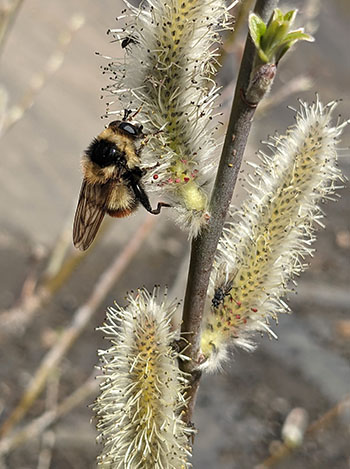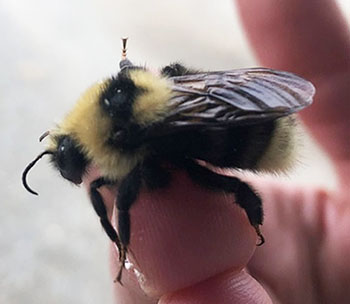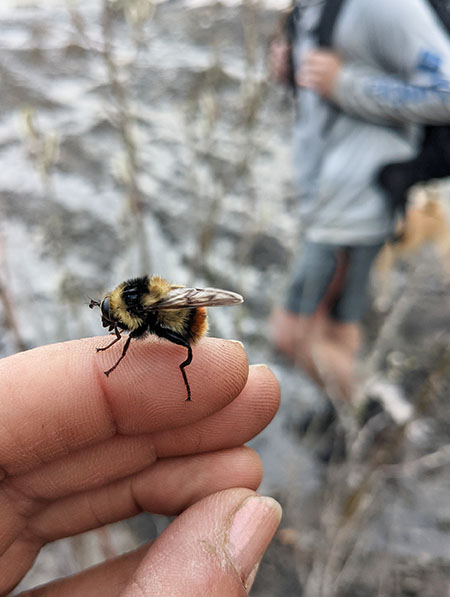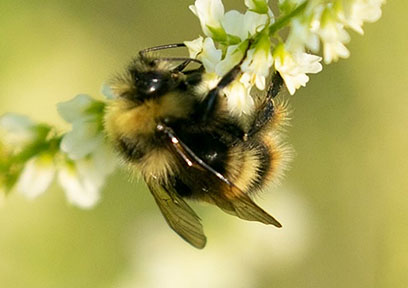Alaska Fish & Wildlife News
September 2023
Nature’s Winged Magicians
Alaska’s Bumblebee Mimic

At the end of Jonesville Mine Road in Sutton, a trail leads you into a mountain cleft where the smallest beginnings of a brook trickles down the craggy sides. My venture there with friends was the result of a fossil-hunting excursion. There were no fossils to be found, but I did encounter a species of willow tree not much taller than I am. Bumblebees were buzzing around in good numbers, Bombus sylvicola, known as Forest Bumblebees. They are iconic bumblebees, and being incredibly fuzzy, do well as pollinators in Alaska.
This is all to say, as an ever-learning naturalist, I was sure that this was B. sylvicola. Not absolutely positive, given there are other bumblebees with similar black-and-orange-and-yellow patterning, but it seemed like a safe bet.
I sent the photos to Dr. Matt Carlson, who specializes in plant and pollination ecology, and whom I’ve reached out to on occasion about pollinator species. I asked if he would be willing to confirm the identification. His response was humbling.
“How about Eristalis - a drone fly, bumblebee mimic,” he said. “Check out the antennae, large eyes, and a single pair of wings.”
A what? I had a book that described mimics. I thought I could spot a mimic, but I suppose that’s why they’re mimics.
“Flower-visiting flies are pretty important pollinators in Alaska and the broader Arctic, but they tend to be ignored because they are diverse, poorly known taxonomically, and not as charismatic as bees,” Dr. Carlson said. “I’m not surprised they were hitting the willows hard.”

In the way that I fell into learning about bumblebees (because I realized I knew nothing about them) I recognized that drone flies were as worthy of attention.
Drone flies are part of a much larger group known as hover flies or flower flies, depending on what part of the world you’re in. Flower flies are a general term for over 900 species of fly in North America that, like magicians, aren’t what they appear to be. Mimicry is particularly useful if the thing you are mimicking has a toxic stinger. Bumblebees are distinguishable by their fuzziness, mostly yellow and black stripes, size, and shape. Signaling to predators that you are not, in fact, a tasty fly, is a marvelous way of ensuring greater survivability. I suspect the particular bumblebee mimic I encountered was Eristalis flavipes, the orange-legged drone fly, but I’d need to double-check with a drone fly and bumblebee specialist to be sure.
Flower flies as a whole have been doing this mimicry for a long time – and they continue to bamboozle even scientists. It was only recently that scientists began looking closely at these insects and their imposters - Russian entomologist Osten-Sacken determined that the drone fly was a false bee in 1898, and they continue to fool humans and predators alike.
The term for a harmless species imitating a more dangerous species is Batesian Mimicry, named after English naturalist Henry Walter Bates. His writings on this, The Naturalist on the River Amazons, cover his in-depth and instrumental work on mimics in South America.

So, if you are on a walk through the woods and are potentially surrounded by these little magicians, how do you spot the differences? In this particular example – a bumblebee versus the orange-legged drone fly – there are a few key details. Bumblebees have four wings (so, two sets of two), but flies are only equipped with two transparent wings. Bumblebees have jointed antennae, meaning that there is a sharp bend close to the base. Drone flies generally have stubby, short, and sometimes thin antennae, sometimes so thin that it’s barely perceptible.
While the sound of their flight is very similar – that deep, low, droning buzzing – their movements are distinguishable from bumblebees. These flies hover, able to hold their flight position without moving, but their movements are more jilted and sharp when they do change direction. Bumblebees tend to move constantly in a languid, easy way, at varying speeds.
While bumblebees do have large eyes, if you look at the drone fly, their eyes just about dominate their heads. Proportionately, they’re much, much bigger. Both bumblebees and drone flies have a set of compound eyes and a set of ocelli (a trio of simple eyes that distinguish light and dark), but the shape is different upon a closer look. Less obviously, you can take a look at the legs. The drone fly is missing the vital corbiculae, or the long, stiff hairs on a female bumblebee’s back legs that serves as the pollen basket.
What they do have in common? They’re excellent pollinators as well. Like bumblebees, the orange-legged drone fly enjoys the nutrient benefits of nectar and pollen, so they spend a lot of time around flowers, hence being part of the group known as flower flies. While bumblebees do excel at carrying pollen, flower flies compensate by the sheer number of flower visits they conduct on their rounds. Being fuzzy, their hair is a fabulous pollen trap, enabling them to carry and exchange thousands of grains of pollen grains between flower visits.

Their beginnings are humble, and usually in dank and murky places, unlike their colorful adult counterparts. While not as attractive as caterpillars, for example, their larvae come into being feeding on dank, decaying organic material. They undergo three larval stages before reaching adulthood, but there isn’t a lot of information available that speaks to how long this takes. After they undergo a pupa stage in a much drier environment, they emerge as drone flies. There’ll be likely two or three generations produced in a single year.
Flies are a really large group. We’re often most occupied thinking of them when we’re chasing one around the kitchen with a flyswatter, or trying to coax our cat to tap into her predatory instincts to snatch one out of the air. They can spread disease because of the other things they’re landing on. Fruit flies multiply exponentially and have to be dealt with through a range of creative means. But many species of flies – like the flower flies – are pollinators and serve an important environmental role. And, as I learned, they can be fascinating.
Subscribe to be notified about new issues
Receive a monthly notice about new issues and articles.
